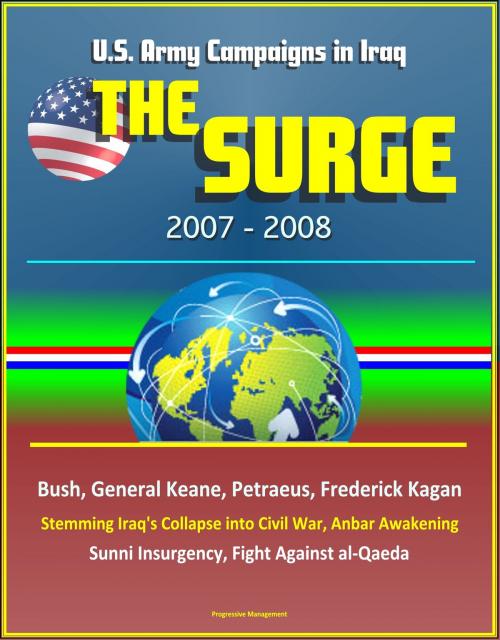The Surge: 2007-2008, U.S. Army Campaigns in Iraq, Bush, General Keane, Petraeus, Frederick Kagan, Stemming Iraq's Collapse into Civil War, Anbar Awakening, Sunni Insurgency, Fight Against al-Qaeda
Nonfiction, History, Military, United States| Author: | Progressive Management | ISBN: | 9781370925605 |
| Publisher: | Progressive Management | Publication: | April 12, 2017 |
| Imprint: | Smashwords Edition | Language: | English |
| Author: | Progressive Management |
| ISBN: | 9781370925605 |
| Publisher: | Progressive Management |
| Publication: | April 12, 2017 |
| Imprint: | Smashwords Edition |
| Language: | English |
This excellent report has been professionally converted for accurate flowing-text e-book format reproduction. More than ten years have passed since the United States invaded Iraq to depose the regime of Saddam Hussein, but the conflict's origins and consequences remain controversial. The immediate cause of the war emerged in the wake of the 11 September 2001 terrorist attacks by al-Qaeda, when the Bush administration sought to preempt potential threats to the United States and its allies. Believing that the Iraqi president was building an arsenal of weapons of mass destruction that he might turn over to terrorists, the administration resolved to remove the Ba'athist regime by force. In its place, the United States sought to build a democratic government at peace with its neighbors that would also be an ally in the Global War on Terrorism.
After the United States and its coalition partners toppled Saddam's government in the spring of 2003, deep-seated tensions between Iraq's various sects, tribes, and ethnic groups filled the vacuum let in the wake of the fallen dictatorship. An anti-American insurgency soon expanded into a broad communal struggle for power and influence in the new Iraq. The United States Army, which was trained and equipped primarily for conventional combat, had to reorient itself for unconventional operations in a complex, irregular war.
Initially, U.S. forces and their partners tried to transition responsibility for maintaining safety and public order to the nascent Iraqi government and its developing security elements. However, these forces were quickly overwhelmed by spiraling levels of violence that threatened to tear the country apart. By 2007, the Bush administration concluded that this approach was failing. To turn the tide, it deployed additional U.S. troops to protect the Iraqi population, cut off insurgent forces from their bases of support and supply, and restore stability. During this timeframe, some opposition elements began to see radical jihadists as a greater threat and began to cooperate with the Iraqi government and U.S. forces. Coupled with the surge, the result was a dramatic reduction in violence. The Obama administration transitioned to Operation New Dawn, which emphasized building up indigenous Iraqi forces and the gradual withdrawal of U.S. forces by the end of 2011.
With these commemorative pamphlets, the U.S. Army Center of Military History aims to provide soldiers and civilians with an overview of Operations Iraqi Freedom and New Dawn. They serve as an account of what the Army did in Iraq and a means of commemorating the hundreds of thousands of servicemen and women who served and the thousands who were killed or wounded in one of the longest conflicts in American history.
This excellent report has been professionally converted for accurate flowing-text e-book format reproduction. More than ten years have passed since the United States invaded Iraq to depose the regime of Saddam Hussein, but the conflict's origins and consequences remain controversial. The immediate cause of the war emerged in the wake of the 11 September 2001 terrorist attacks by al-Qaeda, when the Bush administration sought to preempt potential threats to the United States and its allies. Believing that the Iraqi president was building an arsenal of weapons of mass destruction that he might turn over to terrorists, the administration resolved to remove the Ba'athist regime by force. In its place, the United States sought to build a democratic government at peace with its neighbors that would also be an ally in the Global War on Terrorism.
After the United States and its coalition partners toppled Saddam's government in the spring of 2003, deep-seated tensions between Iraq's various sects, tribes, and ethnic groups filled the vacuum let in the wake of the fallen dictatorship. An anti-American insurgency soon expanded into a broad communal struggle for power and influence in the new Iraq. The United States Army, which was trained and equipped primarily for conventional combat, had to reorient itself for unconventional operations in a complex, irregular war.
Initially, U.S. forces and their partners tried to transition responsibility for maintaining safety and public order to the nascent Iraqi government and its developing security elements. However, these forces were quickly overwhelmed by spiraling levels of violence that threatened to tear the country apart. By 2007, the Bush administration concluded that this approach was failing. To turn the tide, it deployed additional U.S. troops to protect the Iraqi population, cut off insurgent forces from their bases of support and supply, and restore stability. During this timeframe, some opposition elements began to see radical jihadists as a greater threat and began to cooperate with the Iraqi government and U.S. forces. Coupled with the surge, the result was a dramatic reduction in violence. The Obama administration transitioned to Operation New Dawn, which emphasized building up indigenous Iraqi forces and the gradual withdrawal of U.S. forces by the end of 2011.
With these commemorative pamphlets, the U.S. Army Center of Military History aims to provide soldiers and civilians with an overview of Operations Iraqi Freedom and New Dawn. They serve as an account of what the Army did in Iraq and a means of commemorating the hundreds of thousands of servicemen and women who served and the thousands who were killed or wounded in one of the longest conflicts in American history.















